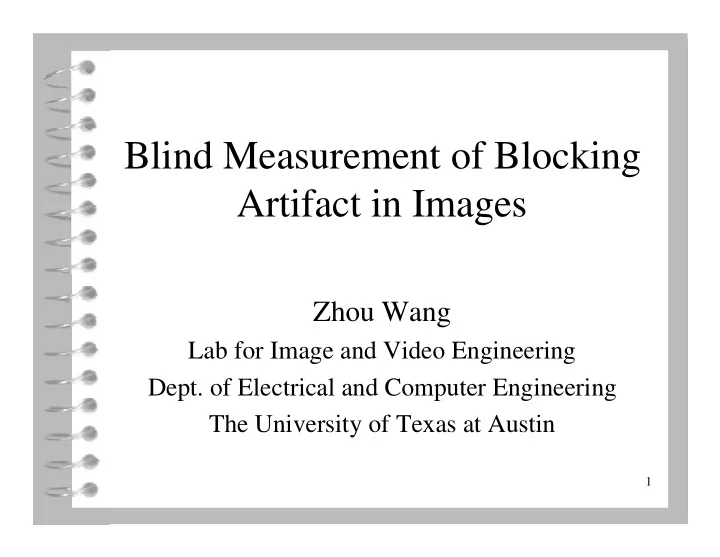

Blind Measurement of Blocking Artifact in Images Zhou Wang Lab for Image and Video Engineering Dept. of Electrical and Computer Engineering The University of Texas at Austin 1
Blocking Effect ➘ Most image/video coding standards use DCT ➘ Quantization is used to achieve low bit rates ➘ Decoding is lossy ➘ Coding artifacts including blocking, blurring, and ringing, etc. ➘ Blocking effect is usually the most significant 2
Blocking Effect Measurement ✔ Applications ➘ Encoder - optimize parameter selection and bit allocation ➘ Decoder - design post-processing algorithm ✔ Measurement Methods ➘ Raw numerical errors - Mean Squared Error (MSE) ➘ Human Visual System (HVS) based metrics ✔ Blind Measurement ➘ Original reference images are not available 3
Proposed Measurement System Power Vertical rows Differen | . | FFT Spectrum Blocking -tiation Estimation Measure Bicoherence Weighting test blocking Estimation & weights image measure Summing Power Horizontal Differen | . | FFT Spectrum Blocking -tiation Estimation Measure columns Bicoherence Estimation weights 4
Power Spectrum 1.5 1.5 1 1 0.5 0.5 0 0 0 0.1 0.2 0.3 0.4 0.5 0 0.1 0.2 0.3 0.4 0.5 ✔ Comparison of power spectra of the blocky and the original images ✔ The blockiness is characterized by the peaks at several feature frequencies 5
Power Spectrum (continued) 1.5 1.5 1 1 0.5 0.5 0 0 0 0.1 0.2 0.3 0.4 0.5 0 0.1 0.2 0.3 0.4 0.5 ✔ In some cases, the image signal itself has a special frequency distribution that may disturb the characteristic frequency components. ✔ Difficult to get a robust measure on power spectrum 6
Ideal 1-D ‘blocky’ signal ✔ 1-D blocky signal 1 0 . 8 0 . 6 0 . 4 0 . 2 0 5 0 1 0 0 1 5 0 2 0 0 2 5 0 3 0 0 3 5 0 4 0 0 4 5 0 5 0 0 ✔ Being differentiated and applied absolute operator 0 . 0 6 0 . 0 5 0 . 0 4 0 . 0 3 0 . 0 2 0 . 0 1 0 5 0 1 0 0 1 5 0 2 0 0 2 5 0 3 0 0 3 5 0 4 0 0 4 5 0 5 0 0 7
Idea 1-D ‘blocky’ signal (cont.) ✔ Magnitude of FFT result 4 3 . 5 3 2 . 5 2 1 . 5 1 0 . 5 0 5 0 1 0 0 1 5 0 2 0 0 2 5 0 3 0 0 3 5 0 4 0 0 4 5 0 5 0 0 ✔ Phase of FFT result 4 3 2 1 0 - 1 - 2 - 3 - 4 5 0 1 0 0 1 5 0 2 0 0 2 5 0 3 0 0 3 5 0 4 0 0 4 5 0 5 0 0 8
Bispectrum - Blocky Image 9
Bispectrum - Original Image 10
Blocking Metric ✔ Vertical Blocking Metric 2 [ / 8 , / 4 ] = ⋅ γ M C N N Bv XXX ( [ / 8 ] [ / 4 ] [ 3 / 8 ]) ⋅ + + P N P N P N ✔ Overall Blocking Metric 0 . 5 0 . 5 = + M M M B Bv Bh 11
Modified Measurement System Power Vertical rows Differen | . | Masking FFT Spectrum Blocking -tiation Estimation Measure Bicoherence Weighting test Masker blocking Estimation & weights image Evaluation measure Summing Power Horizontal Differen | . | Masking FFT Spectrum Blocking -tiation Estimation Measure columns Bicoherence Estimation weights 12
Masker Evaluation ✔ Luminance masking ➘ more sensitive to mid- level errors ✔ Local activity masking ➘ more sensitive to errors in smooth areas � Brighter - stronger masker � Darker - weaker masker 13
Measurement Results - ‘Lena’ 20 Proposed blocking measure Combining masking effects 15 10 5 0 0 0.1 0.2 0.3 0.4 0.5 0.6 0.7 0.8 14
Measurement Results - ‘Barbara’ 20 Proposed blocking measure Combining masking effects 15 10 5 0 0 0.1 0.2 0.3 0.4 0.5 0.6 0.7 0.8 15
Conclusions - What has been done? ✔ A new blind blocking artifact measurement system is developed. This method is deterministic. No parameter needs to be pre-defined. ✔ A modified version of the measurement system has also been developed, which combines human visual masking effects. 16
Conclusions - What’s new? ✔ The new measurement systems can be applied blindly, while most of the other image quality measures need the reference images. ✔ The new algorithms employ higher order statistics (HOS) features. It is a new application of HOS technique in the field of image processing. 17
Conclusions - What’s new? (cont.) ✔ Several statistical features of the image signals (power spectrum, bispectrum, biconherence) have found to be related to blocking effect. ✔ The most interesting feature is the bispectrum, which may be viewed as a signature of blockiness. 18
Recommend
More recommend